UniShare is a simple tool that ensures that everyone has access to the information they need, when they need it.
How does UniShare fit into the USM?
What is UniShare?
UniShare is a Customer Relationship Management (CRM) tool for recording interactions with students, prospective students and staff. It can be used to access information relating to previous queries, track responses and refer queries to other areas or individual. UniShare also provides detailed reports and statistics, allowing an overview of emerging business trends, planning staffing levels and informing changes or updates to services.
Who uses it?
It is used in a number of areas across the university including:
- Programme-level offices in all Colleges
- Student Advisers in all Colleges
- UCD Registry
- College Liaison Librarians in UCD Library
- Access & Lifelong Learning
How does UniShare work as part of the USM?
With the focus of providing a consistently high level of support to students across the university, the system assists in co-ordination and consistency among staff. It allows all team members to quickly and easily get up-to-speed with the status of student cases. The system also provides a referable record of decisions agreed actions and other outcomes arising from all interactions. The team are unified in their approach to student supports with the help of UniShare.
In a USM-Live office, UniShare is used in the following instances:
- In any 1-to-1 interaction that takes place between a member of your team and a student.
- In any interaction with a staff member that involves an individual student
What have UniShare users said?
In our rollout of UniShare so far, we’ve heard quite a bit from those using the system to support their services:
Sharing – Being able to share information between members of the team is very useful. Also, the functionality to share information between the office and the school/Student Desk/Student Advisers is seen as a significant opportunity moving forward.
Complete picture – Having a complete picture of the student’s interactions with the team is very useful for everyone involved. Staff have the full picture of the student's previous interactions with the office and can provide a consistently high standard of support based on this.
Less Guesswork – Reduces the amount of guesswork/anecdotal evidence from previous interactions.
Saves Time - Both for staff and students. Acts as a good source of information at first contact meaning less time revisiting paper-notes or trying to decipher what the student was told or by whom.
Clarity – Provides a clearer picture of what support has previously been given.
As more users come on board, further feedback will be gathered and used to inform developments and enhancements to the system to ensure that it achieves more for everyone.
If you would like to use UniShare, please register (opens in a new window)HERE.
If you are interested in learning more about UniShare or would like to arrange training for your team, please get in touch!
UniShare Statistics
The USM works on three levels, unified for the individual, unified for the team, and unified for the university, and the data we collect via UniShare supports these three unifieds.
At an individual level, every logged interaction captures a query or need. For teams, UniShare data can be used to identify peaks and troughs, better plan, and identify pain points. By analysing data at the level of the university, the university can identify areas for improvement and make data-driven decisions to enhance student experiences.
In essence, the value of UniShare lies not just in its ability to manage interactions with students or other stakeholders, but also in the insights that can be gained from the data it collects. By tracking and measuring key metrics, the university can gain a better understanding of how to improve its operations and achieve its strategic goals. As the saying goes, "you can't improve what you don't measure," and UniShare provides the university with the means to measure and improve its performance in critical areas.
The following charts break down UniShare data at the level of the university (areas rolled out to by the USM) for academic years 2018 to 2022 (2022 data includes the Autumn trimester only). The charts show:
- Figure 1: UniShare interactions
- Figure 2: UniShare users, i.e. the number of staff using UniShare
- Figure 3: UniShare areas/offices
- Figure 4: UniShare categories
- Figure 5: UniShare tasks
One way to measure the impact of UniShare is to look at the total number of interactions that are logged each year. As you can see from Figure 1, the number of interactions has been steadily increasing over the past few academic years, which is a testament to the hard work and dedication of our staff.
Figure 1:
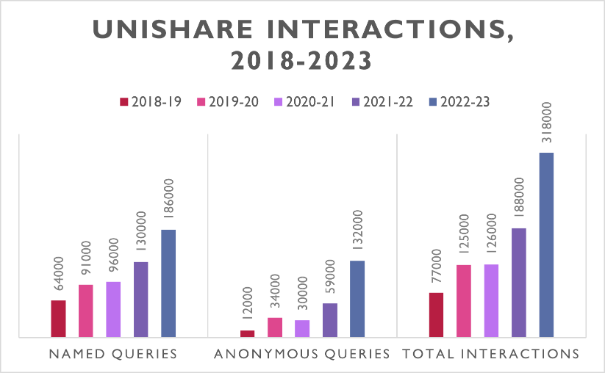
- ‘Named Queries’ are those interactions that have been logged against a students record
- ‘Anonymous Queries’ are those interactions that have not been logged against a student record. Staff use Anonymous Queries when they want to record that an interaction has occurred but it is not necessary to share the details of that interaction with others, or to record details for future reference
- ‘Total Interactions’ is the sum of the ‘Named Queries’ and ‘Anonymous Queries’
Another thing we can measure is the number of staff and offices using UniShare. As can be seen below there has been a steady increase in the number of staff (Figure 2) and offices (Figure 3) using UniShare over the past few years which demonstrates the increasing importance of UniShare to the way we work in UCD.
Figure 2:
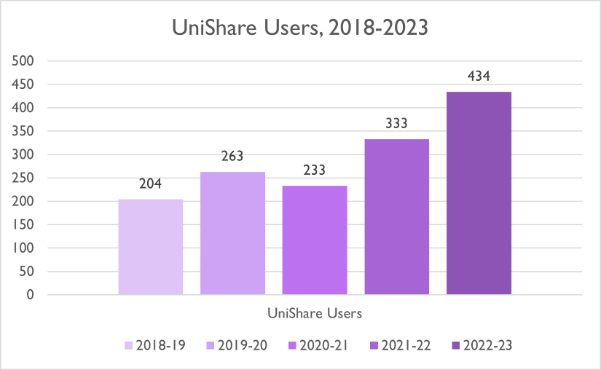
Figure 3:
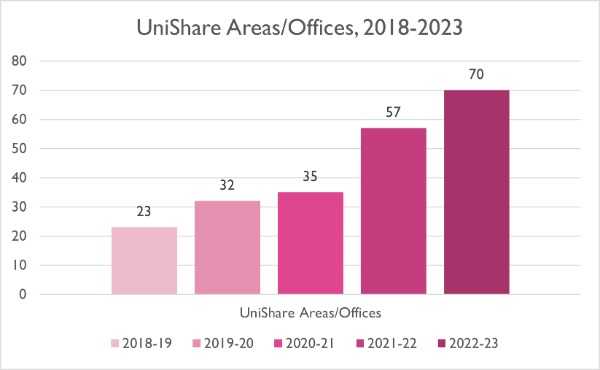
- A ‘UniShare User’ is defined above as someone who used the system at least once in the year
- Some units have multiple UniShare areas
The number of categories (Figure 4) and tasks (Figure 5) that are used in UniShare have been increasing, which demonstrates growth in the use of the system over time. This gives us a sense of the increasing complexity of the work that is being captured on UniShare, although these charts do not provide insights into the type of interactions that are happening.
Figure 4:
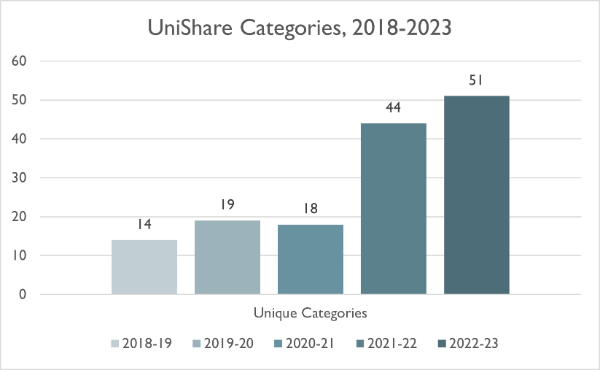
Figure 5:
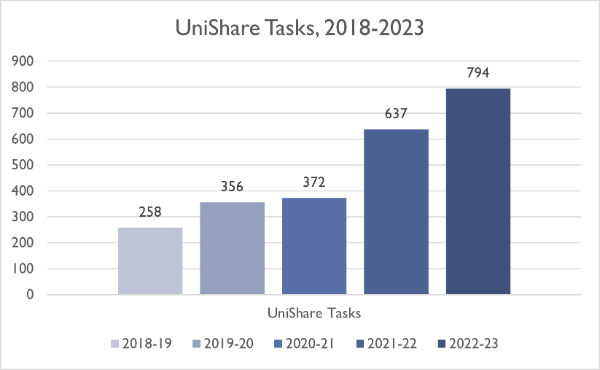
- UniShare tasks are grouped into categories like Assessment, Admissions, Registration etc
- Examples of UniShare tasks include Clinical Placement, Fees Query, and Manual Registration Request
- The number of tasks used has grown as the rollout has progressed
Overall, these charts provide valuable insights into the growing importance of UniShare in our day-to-day operations.